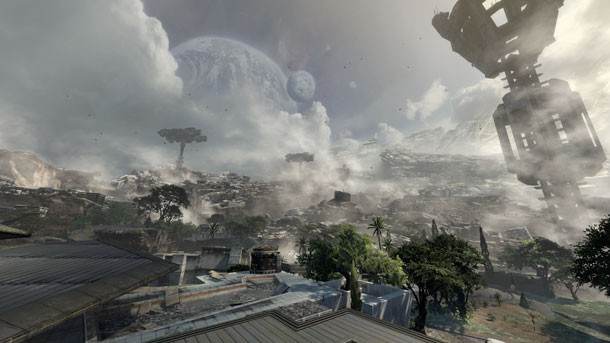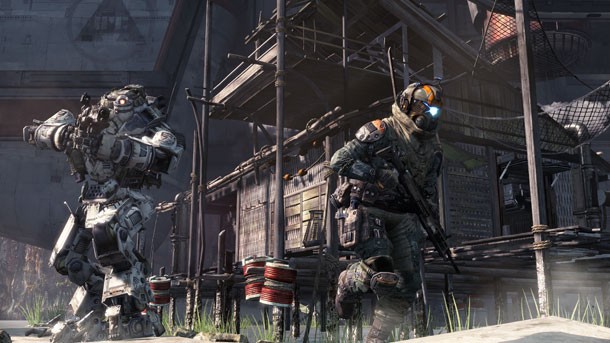Titanfall And Relatable Sci-Fi

One of the questions we had for Respawn was why the studio wanted to go down the sci-fi route with Titanfall. The reason came down to simple pragmatism. “There’s only so far you can go if you’re portraying [a conventional] military,” says game director Steve Fukuda. “A big part of it is if you want a guy to be able to leap buildings in a single bound or we want people to be able to cloak – if you want people to be able to do exotic things and have somewhat outlandish things happen, it makes it easier if you can sort of explain it away or you have a mechanism for doing that, and sci-fi served that purpose.”
When work on what would become Titanfall began in earnest, one of Respawn Entertainment’s internal mandates was to make something relatable. The term “science fiction” means a lot of things to a lot of people, and given its rich background in military shooters the team didn’t want to travel too far off from our current reality. Even with its sci-fi trappings, Titanfall looks more in like with a modern combat game than the typical sci-fi shooter with its glossy hallways or meetings between rubber-faced alien council members.
“A lot of gamers, especially those who like shooters, when they think of sci-fi they think of Mass Effect and pew-pew lasers,” says Respawn Entertainment community manager Abbie Heppe. “We are not a pew-pew laser game.”
Titanfall’s futuristic setting includes plenty of fantastical elements – those 24-foot-tall Titans are difficult to overlook – but the battlefields won’t be crisscrossed with pink and blue laser beams. Instead, this is a world of rivets, cordite, and rough-hewn armor plating.
“When we discussed how this game should look, ultimately it was a big deal to not really look completely sci-fi, but to look believable and genuine,” says lead artist Joel Emslie. “It’s more the Blade Runner or District 9 vibe."
The story is also grounded in contemporary reality, even though it takes place light years away. “The basic backstory fiction is that there’s a core civilization on Earth, but then at some point a lot of people decide that they were going to try their luck at this area called the frontier, which is kind of a new gold rush,” says Fukuda.

The two playable factions in Titanfall are the settlers, who have been building in and exploring these new worlds, and a massive corporation moving in to claim the natural resources. Fukuda won’t provide dates, but he jokes that the game takes place further in the future than anyone reading this will ever see. Even though locations may be light years away from Earth, familiar elements abound – it’s a universe where mundane things like coffee shops, fire hydrants, and parking meters still exist, even if they’re all far away from our own solar system.
In their time away from Earth, the settlers have developed their own culture and militia. It’s understandable that an encroachment from the IMC (Interstellar Manufacturing Corporation) ruffles feathers. “They’re coming out to explore, to exploit, various areas of the frontier, and that’s where the conflict begins,” Fukuda says. “That’s where the conflict actually happens between the representatives of the settlers, the militia, and the people coming from various locations on Earth and the IMC coming from those core systems.”
Titanfall doesn’t provide separate single- and multiplayer experiences. Instead, Respawn is working to combine the strengths of both. That poses a challenge, as you can imagine. “How do we sell a universe in a multiplayer universe?” Fukuda recalls asking. “How do we make multiplayer more cinematic? Because that was something we felt hadn’t really been explored, or at least not enough. From there, that’s what got us Titanfall.”
Respawn wants to avoid telling story through cutscenes and talking heads. Instead, players absorb elements on their own by paying attention to smaller details. Linger in an apartment complex, for example, and you might notice signs that the residents were forcefully evacuated before the battle started. Respawn is also adding those bombastic moments that we’ve grown accustomed to seeing in FPS campaigns.
“In one particular situation, there’s what we call a dog-whistle tower,” Fukuda says. “It’s a massive, massive Space Needle-type structure that sends out a signal that repulses a lot of creatures on the outskirts of this IMC facility. When that thing goes down, that’s bad news.”
We saw the tower during the game demo, and it kept a variety of manta ray-like beasts at bay as they circled high above the battle. Fukuda says that players will also get to see the aftermath of the device going down, after the creatures have had their fill of human flesh.
As it turns out, sci-fi is a perfect vehicle for making the unbelievable believable – with or without pew-pew lasers.

Get the Game Informer Print Edition!
Explore your favorite games in premium print format, delivered to your door.
- 10 issues per year
- Only $4.80 per issue
- Full digital magazine archive access
- Since 1991










